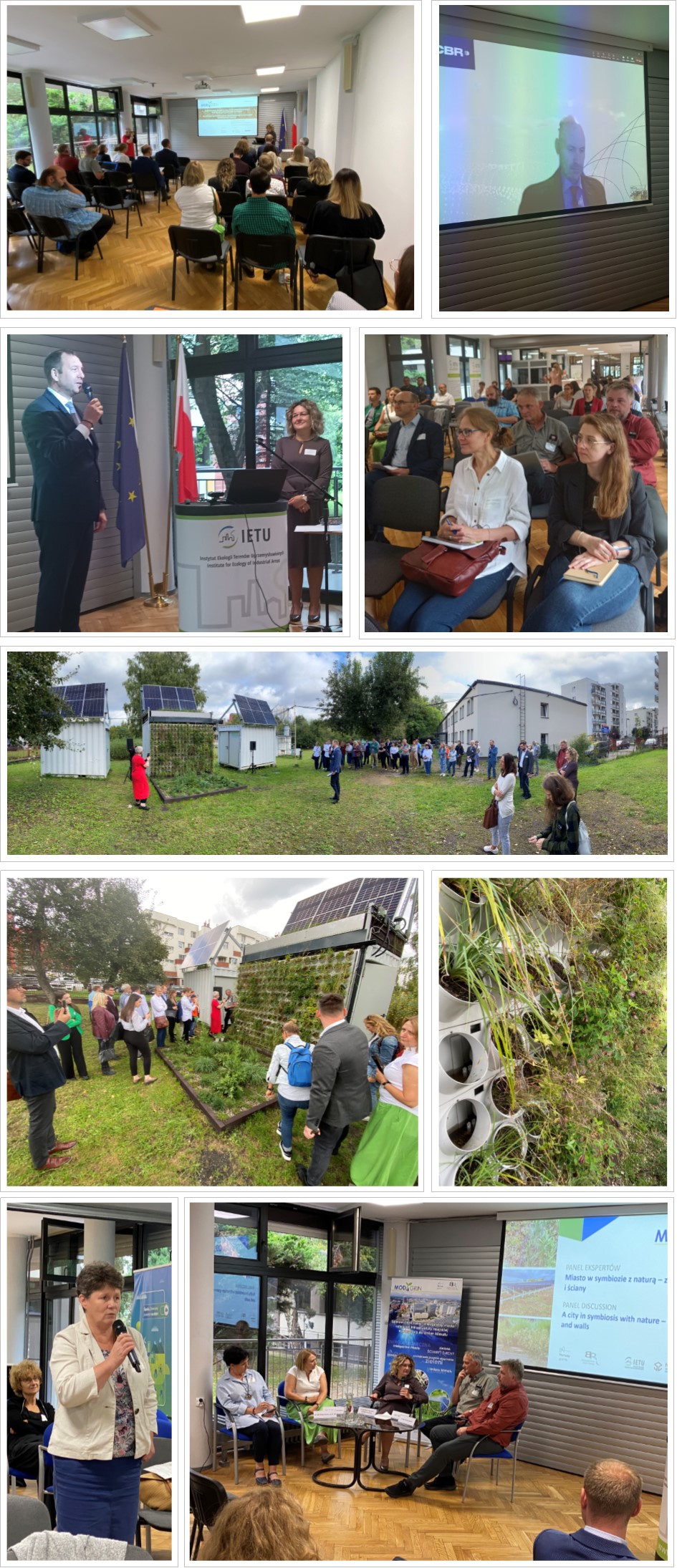- Yesterday, guests of the conference summarising the results of the MOD4GRIN project were shown a self-sufficient, intelligent module of green urban infrastructure. It was prepared by scientists from IETU and the Norwegian Institute of Bioeconomy Research. The module is equipped with an energy supply system consisting of photovoltaic panels and energy storage, as well as a communication infrastructure enabling the transfer of measurement data. Apart from that it also has an air quality monitoring system and an automatic irrigation system. It is planted with native plant species selected from xerothermic grasslands and propagated in the nursery located on the IETU premises.
How to introduce greenery into heavily built-up areas? How to improve the local climate and increase biodiversity at the same time? By installing green roofs and green walls. Residential and public buildings should be ecological. Green roofs and walls in the building are an example of eco-solutions that will help reduce the "heat island" effect and collect rainwater, which is later used to water plants. In addition, properly selected species of native plants, resistant to drought, high and low temperatures or air pollution, will enrich urban biodiversity.
Opening the conference of the project Self-sufficient, intelligent module of green urban infrastructure in adaptation to climate change - MOD4GRIN, Cezary Błaszczyk, Deputy Director of the International Cooperation Department of the National Centre for Research and Development, said that the National Centre for Research and Development (NCBR) supported projects of high scientific value, characterised by innovative solutions, which would be implemented after their completion. The MOD4GRIN project received funding from the Applied Research Programme implemented under the Norwegian Financial Mechanism 2014-2021. The unit IETU scientists cooperate with is the Norwegian Institute of Bioeconomy Research (NIBIO).
Mariusz Skiba, Vice-president of Katowice, emphasised that IETU had always been looking for innovative solutions which aimed at the city development. He also thanked the representatives of NIBIO for their financial support of the research and their willingness to share knowledge and experience.
During the conference, scientists presented the results of experiments carried out in Poland and Norway.
We were inspired by Norwegian green roofs where native plant species were grown. Since maintaining green roofs and walls is expensive, we decided to look for a solution in the symbiosis of nature with innovative technologies to reduce costs - explains Dr. hab. Marta Pogrzeba, Professor and Director of IETU and Coordinator of the MOD4GRIN project.
Dr. Hans Martin Hanslin from NIBIO presented the results of research related to the design of substrates for green roofs and walls. Dr. Jacek Krzyżak from IETU discussed how abiotic stress, nutrient content and co-planting affect the growth and suitability of some plant species selected for urban green infrastructure.
For the wall and roof, we chose plant species from xerothermic grasslands, including: Festuca ovina, Potentilla reptans, Trifolium repens, Sedum acre, Dianthus carthusianorum, Salvinia verticillata, Fragaria viridis, Achillea millefolium and Carex flacca. They are characterised by resistance to stress factors occurring in the urban environment, such as varied access to water resources, high/low temperature, or pollution. Under the project the stress resistance of species from the native flora of Poland and Norway, which were selected for demonstrators in both countries was examined - says Dr. Jacek Krzyżak from IETU.
The IT solutions used in the self-sufficient, intelligent green urban infrastructure module were discussed by Dr. Szymon Rusinowski, from CommLED Solutions.
Then, there was a demonstration of the self-sufficient, intelligent green infrastructure module, led by Dr. Jacek Burgulat. Conference participants asked many questions both about the plant species selected for the wall and roof and the applied IT solutions.
In 2022, together with the planting of plants, the system supplying the module with energy, consisting of photovoltaic panels and a small energy storage unit, as well as all planned systems monitoring the condition of the wall and roof were launched. In 2023, monitoring of air parameters (temperature, humidity, atmospheric pressure, suspended dust) began. An irrigation system was also launched. It consists of soil humidity and temperature sensors as well as a pump controller, which are managed from the server level - informs Dr. Szymon Rusinowski from CommLED Solutions.
After the demonstration of the MOD4GRIN module, Prof. Trygve S. Aamlid from NIBIO presented how the system for the production of native seed material for the needs of urban greenery had been prepared in Norway. Work on the system lasted five years - it started in 2017. In the production of plant material research institutes are involved.
The conference ended with the panel "City in symbiosis with nature - green roofs and walls", in which Dr. Hans M. Hanslin and Prof. Trygve S. Aamlid from NIBIO, Dr. hab. Edyta Sierka from University of Silesia and Magdalena Biela from the Urban Greenery Department in Katowice took part. The moderator was Dr. Marta Pogrzeba, Professor and Director of IETU. The background for the discussion was the maintenance of greenery in the city and its role as the key element in the city's adaptation to climate change, but the main focus was on three issues: back to nature - wild plants return to the city, nature in symbiosis with innovative technologies, and benefits for the urban climate and residents, as well as - costs and new problems for local governments.
Among the participants of the event there were representatives of municipalities interested in the subject of green roofs and facades, enterprises responsible for urban greenery management, urban gardeners, landscape architects, universities, scientists, non-governmental organisations, as well as other people interested in introducing greenery in the city.



